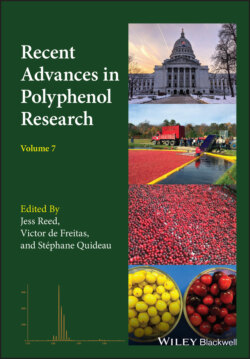Читать книгу Recent Advances in Polyphenol Research - Группа авторов - Страница 54
3.6 Commercialization Prospects for Wildcrafted Polyphenol‐rich Plants
ОглавлениеThe exceptionally high polyphenol content and diverse profiles found in wild plants have led to their incorporation in new functional food and cosmeceutical formulations. There is a global trend favoring clean labels on food and cosmetic products, which has been the impetus behind industrial interest in using wild‐harvested plants as natural sources for antioxidants, flavorings, and antimicrobials in unique yogurt and cheese products and topical moisturizers (Pinela et al. 2017; Jacobsen et al. 2019).
For example, as a consequence of the current consumer trend towards natural, healthy foods from clean environments, edible macroalgae or seaweeds are increasingly consumed as trendsetting foods and condiments. Seaweeds, which were until recently harvested only by native groups, feature a range of antioxidant compounds (phlorotannins, pigments, tocopherols, and polysaccharides) which can now be efficiently, economically extracted from wild species, and/or wild seaweeds have been brought into industrial cultivation (Jacobsen et al. 2019). These advances have increased the impetus for the pharmaceutical industry to develop novel antidiabetic, anticarcinogenic, and anti‐inflammatory drugs from extracted phytoactives from seaweeds, particularly in Asia (Abirami et al. 2018). The polyphenolic (phlorotannin) content of seaweeds has been the impetus for the launch of new cosmeceutical and pharmacological products based on radiation protective, prebiotic, antibiotic, and antidiabetic attributes. The resiliency of native plants thriving under harsh environmental extremes has provided a novel marketing angle for these derived products. Biorefineries worldwide are currently using seaweeds in bulk as feedstock based on functional (prebiotic and anti‐inflammatory) bioactive properties (Holdt and Kraan 2011). Similarly, arctic berries which flourish in the extended 23 h photoperiod of the tundra regions and survive harsh conditions have become niche ingredients for novel edible products as well as cosmeceutical formulations (Kellogg et al. 2011).
Despite escalating investments in pharmaceutical research, the innovation capacity of industrial R and D models has appeared to stagnate. Safety issues are generally addressed rather late in the typical drug development pipeline, and can easily be responsible for failure of drug approval. In contrast, the alternative and time‐tested “reverse pharmacology” approach, based on the leads from traditional ecological medicines and a long history of human use, allows safety issues to be addressed early in the discovery process, and can significantly reduce time and costs while introducing novel new treatment approaches to modern consumers (Andrae‐Marobela et al. 2012).
